INTRODUCTION
Alan Gamlen, Monash University
Human geopolitics, the competition for population rather than territory, has preceded violent conflict throughout world history (Gamlen 2019). Such competitions have been minimised since the Peace of Westphalia, which brought an end to the Thirty Years War in the mid-seventeenth century, setting in place the territorial foundations of the modern international system. But human geopolitics is being resurrected today in unanticipated ways, as this system evolves and governments are allowed and encouraged to engage their emigrant diasporas through ‘diaspora institutions’.
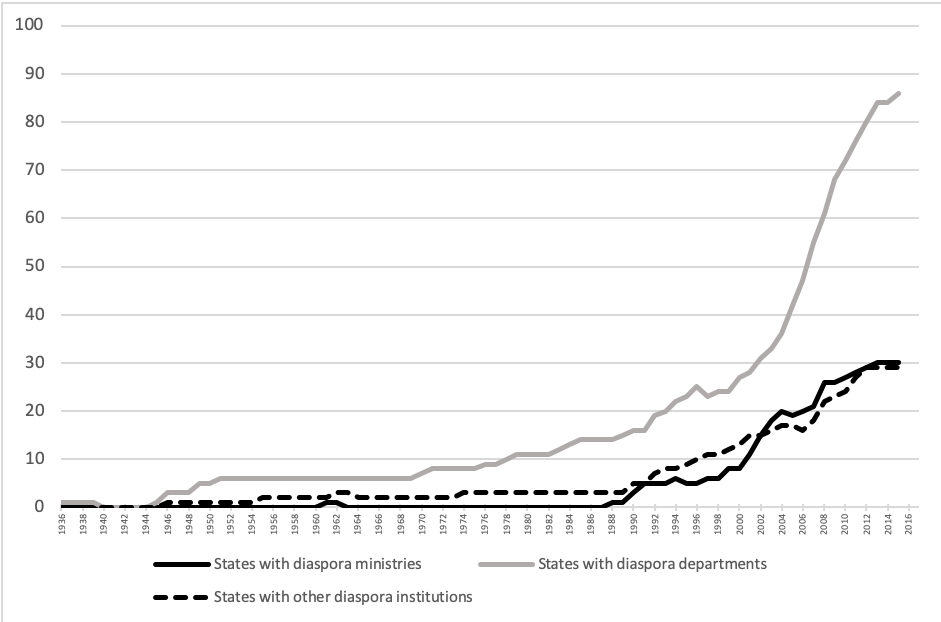
Diaspora institutions are formal government offices dedicated to emigrants and their descendants abroad. Examples include the Ministry of Overseas Indian Affairs (2004–16), Serbia’s Ministry of Religion and Diaspora (2003–12), the Irish Abroad Unit, Nepal’s Department of Overseas Employment, Nigeria’s House Committee on Diaspora Affairs, and the dedicated legislature seats for diaspora representatives that exist in a dozen countries including France and Italy. The stated purposes of diaspora institutions typically include managing the export of migrant labour; recognizing and addressing diaspora views and concerns; channelling their remittances into development projects and celebrating their contributions; preserving diaspora cultural identities and ties; and cultivating networks of affluent and influential compatriots abroad as informal ambassadors or lobbyists (see Figure 2). Many of these are laudable aims connected with mutually beneficial social and economic development. But others are more unsettling.
Diaspora institutions have recently become remarkably widespread and standardised, despite the fact that they seem to violate some of the central rules of the modern international system. In 1980, there was only a motley handful of diaspora institutions in existence, but now well over half of all United Nations member states have one (see Figure 1). And yet, these institutions potentially interfere in the domestic affairs of foreign states, raising concerns about conflicting sovereignty claims – such as when Turkish authorities tell Turks in Europe that “assimilation is a crime against humanity” (Pleitgen 2016). They potentially interfere with the freedom of exit of emigrants, who may want to sever their ties to their former homeland – such as when Chinese authorities intimidate expatriate fugitives or their families in China (The Economist, 2018). They also potentially give influence over law-making to people living abroad who are not subject to the resulting laws – such as when Ethiopian social media influencers in Minnesota mobilise ethnic opposition to the government in Addis Ababa (Peralta 2018).
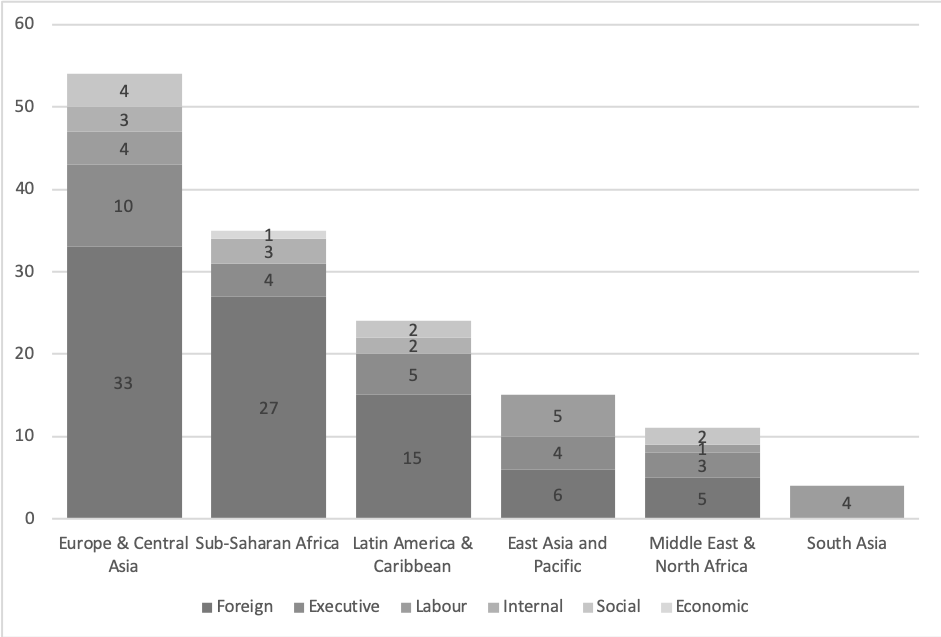
Against this background, it may seem paradoxical that diaspora institutions are now officially promoted by leading international organisations such as the International Organization for Migration. And this is indeed a puzzling area. On the issue of diasporas today, there seem to be conflicting expectations of what constitutes good behaviour worthy of a respectable state. For example, most international commentators cried foul when Russia annexed Crimea in 2014, saying it “is aware of its responsibility for the lives of compatriots and fellow citizens in Ukraine and reserves the right to take people under its protection” (Golubkova, Heritage & Gutterman 2014). But they had applauded heartily just six months earlier when the same foreign ministry declared, at the International Organization for Migration’s ‘Inaugural Diaspora Ministerial Conference’, that “The Russian Federation will continue to protect the rights and legitimate interests of compatriots… We will continue to assist them in maintaining their mother-tongue in preservation of Russian culture and traditions in establishing stronger links with their historical homeland” (Smirnova 2013).
What explains this apparent contradiction? How have these conflicting expectations arisen? What explains the rise of these ‘diaspora institutions’, and how does it relate to the political geographies of decolonization, regional integration and global governance since World War II? How is it changing the rules of world politics, and how should the international community respond? Until now these questions have been difficult to answer. The majority of research attention has focused on questions of immigration policy in a handful of wealthy migrant destination countries, largely ignoring the emigration policies that preoccupy the world’s many migrant origin states.
Human Geopolitics addresses that research imbalance, by focusing on the overlooked sending side of migration policy. Drawing on data covering all United Nations members across the post-WWII period, and fieldwork with high-level policy makers across dozens of states and international organisations, the book explains how the spread of diaspora institutions has been driven by efforts to strengthen international cooperation in the field of migration. It shows how these institutions—while largely benign and development-focused—are sometimes touching off episodes of human geopolitics, involving growing inter-state competitions for population rather than territory. And it calls for the formation of stronger guiding principles and evaluation frameworks to govern these new state-diaspora relations in an era of unprecedented global interdependence.
Explaining the Rise of Diaspora Institutions
Existing explanations for the rise of diaspora institutions are still patchy. Some studies argue that states like India, Mexico, Israel, Ireland and the Philippines are strategically establishing diaspora institutions to tap into the material resourcesof emigrants and their descendants, including their remittances, their investments, and their influence, to gain access to decision makers and opinion shapers abroad, and to transfer ideas and technologies back to their homeland (Esman 2009; Gillespie & Andriasova 2008; Kapur 2001; Riddle & Marano 2008; Shain 1999). Other studies of regions like the Balkans or the Black Sea region argue that nationalist regimes are extending citizenship abroad to embrace what they see as a missing portionof the ethnic nation—lost during previous territorial changes, but not forgotten (Anderson 1992; Csergo & Goldgeier 2004; Schiller 2005; Schiller, Basch & Blanc‐Szanton 1992; Schiller & Fouron 1999; Skrbiš 1999). The many variants on these standard theoretical approaches often explain the diaspora strategies of specific states, but they struggle to explain the recent and rapid global rise of diaspora institutions more broadly. This is partly a methodological limitation: with a few notable exceptions, research in this area is based on small-sample case studies that are well-equipped to explain what individual states are doing, but not well equipped to explain why so many states are doing the same thing at the same time (Gamlen 2014; Gamlen & McIntyre 2018).
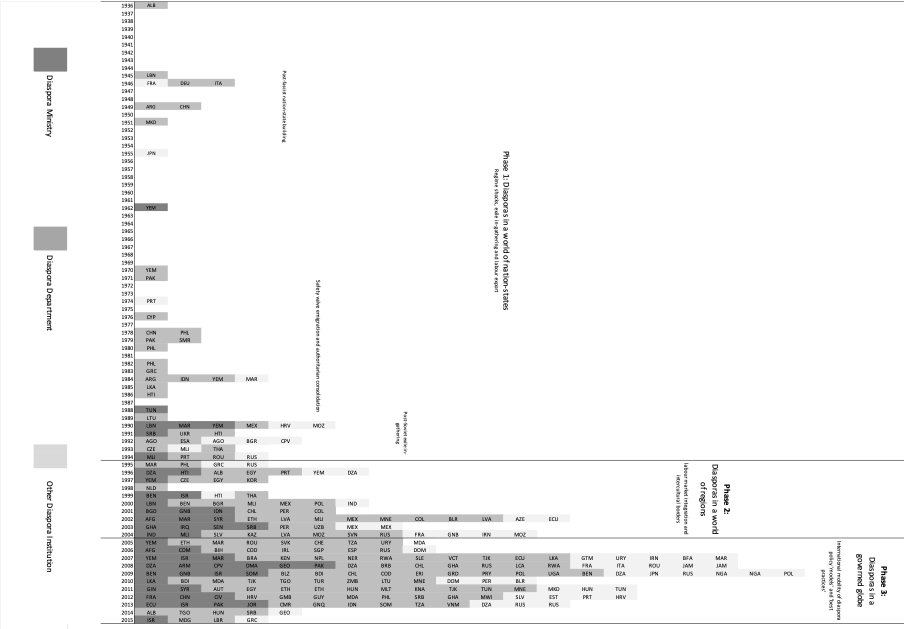
Human Geopolitics offers a new methodological and conceptual approach to explaining the phenomenal global spread of diaspora institutions. Methodologically, it combines large-scale quantitative comparison covering all United Nations Member States, with extensive in-depth interviews and fieldwork covering dozens of governments. Like any research, it has its limitations, but no previous study has aimed at similar comparative and longitudinal scope. Conceptually, the book provides a new institutional explanation for the phenomenal spread of government diaspora outreach efforts. The institution in question is the emerging global migration regime. The book explains how, in the early 2000s, the United Nations and related organisations began calling for greater international coordination on international migration, which has long been considered ‘the missing regime’ of global governance (Betts 2011; Gamlen 2011; Gamlen & Marsh 2011). It shows how Kofi Annan’s administration pursued this controversial goal by launching a soft campaign of informal, non-binding, state-led dialogue over migration, based around sharing the ‘best practices’ that helped migration foster social and economic development (Annan 2006). And it demonstrates how ‘engaging diasporas’ became one of the most prominent ‘best practices’ that emerged as states fell in behind this international agenda—aided by an industry of think tanks, consultancies, NGOs and professional migration experts, who have turned diaspora engagement into a ‘model’ of development-friendly migration management.
Human Geopolitics also studies the emergence of diaspora institutions before their recent global proliferation. It identifies three phases, each of which is explored in more detail in a series of chapters (see Figure 3). Phase one stretched from the mid-twentieth century to the early 1990s; in this period, a few states formed diaspora institutions to help them gather in their exiles as part of post-colonial nation-state building efforts. Phase 2 took off from the mid-1990s, when diaspora institutions gradually became more widespread and accepted as part of the standard policy toolkits for managing mobility within the EU and other regional integration schemes. But they remained relatively rare. The most recent, and by far the most important, phase in the rise of diaspora institutions began in the early to mid-2000s. In this period, diaspora institutions were aggressively promoted by international organisations, by migration experts, by first-mover states, and by an industry of consultants. As a result, a great cascade of diaspora institutions emerged around the world.
The structure of Human Geopolitics tracks this historical development. Chapter 2 provides a descriptive overview of data, describing the range of diaspora institution forms and functions found around the world, and identifying three historical phases in their global spread. Chapter 3 examines Phase 1 of the process, introducing the concept of ‘regime shock’ to help explain the spread of diaspora institutions as part of the fragmentation of totalitarian empires during the twentieth century, as countries gathered in their exiles to redefine themselves during moments of post-colonial existential crisis. Chapter 4 drills down into specific case studies of three well-known diaspora institutions, in Mexico, India, and Eritrea, through in-depth interviews with relevant senior policy makers. Emphasizing the strengths of a mixed-methods approach, the chapter fleshes out the dynamics of regime shock and diaspora institution formation introduced previously.
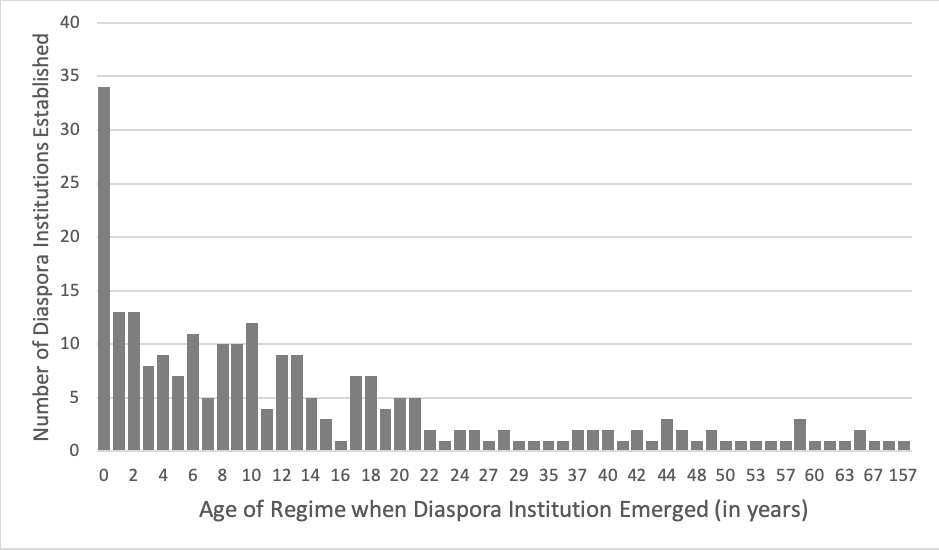
Chapter 5 is the first of several regionally focused chapters: it covers countries across South and Central Asia and elsewhere from the 1970s, in which diaspora institutions have been less about exile in-gathering and more about avoiding regime shocks through safety-valve emigration and labour export, often to support the consolidation of authoritarianism. Chapter 6 shifts to Phase 2 in the rise of diaspora institutions, describing the spread of diaspora institutions from the mid-1990s, as a ‘model’ of migration management in regional integration schemes like the EU, sometimes releasing pent-up nationalisms and dredging up past territorial disputes. Chapter 7 maps a region in which the dynamics of state competition over population have grown particularly tense since the mid-1990s, as governments in the Black Sea zone have used their diaspora policies to jockey for position between regional hegemons of Europe, Russia, and Turkey.

As Figure 1.3 shows, by far the most dramatic global rise of diaspora institutions occurred from 2005. The next three chapters examine the massive shift in global perceptions and realities that this involved. Chapter 8 shows how diaspora engagement shifted from a regional model of migration management to a global best practice. In the late 1990s, engaging diasporas was openly but rather quietly advocated by a range of regional organisations—but from 2006, the Secretary General of the United Nations had become a cheerleader. Chapter 9 shows how the widespread adoption of diaspora institution models and best practices has been orchestrated by international organisations, and supported by the actions of a ‘diaspora engagement industry’ of professional consultants, think tanks, and NGOs working on the topic. Chapter 10 studies how states have learned from and taught each other as they all strive to implement the recommendations of international organisations and experts—providing clear evidence of many cases where states’ diaspora institutions have been driven not by their national interests, but by their conformity to changing international norms.
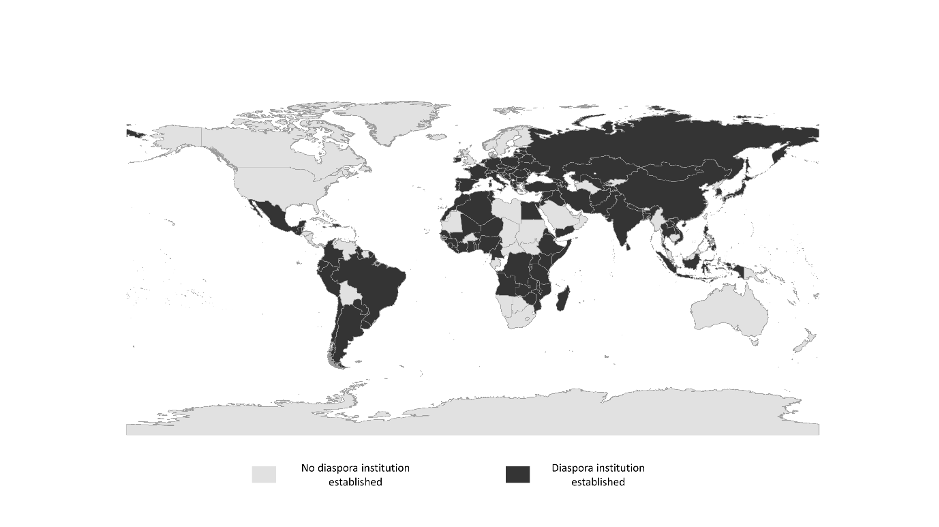
Chapter 11 summarises the central argument of the book—that the rise of diaspora institutions is being driven by the evolution of a global migration regime, and is touching off human geopolitics in some parts of the world. The chapter highlights the main conceptual and practical contributions of the book, and highlights priorities for future research.
In a nutshell, this book argues that the evolution of a global migration regime has driven the recent rise of diaspora institutions, and that this in turn has helped unleash a new wave of human geopolitics around the world. This dynamic has largely caught social scientists unprepared, as it has emerged from a grey zone between the separate disciplines of comparative politics and international relations. But it is important to understand, not least for practical reasons: when previously banned policies become ubiquitous so quickly, there is at least a possibility that bad practices are sometimes masquerading as ‘models’. As Human Geopolitics documents, in the absence of an agreed set of principles about what constitutes reasonable diaspora engagement, governments in many parts of the world have begun to treat troubling interference with ‘their’ citizens abroad as part of normal politics. As the book suggests, with the implementation of the Global Compact on Safe and Orderly Migration currently underway, and the International Organization for Migration now embedded within the United Nations family, it is a good time for the international community to develop clearer principles and standards that institutionalise the best aspects of diaspora engagement, while firmly guarding against the further spread of human geopolitics.
Human Geopolitics has received the 2020 ENMISA Distinguished Book Award.
